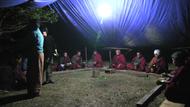Video Overview
Abstract:
Despite decades of research, effects of different types of meditation on electroencephalographic (EEG) activity are still being defined. We compared practitioners of three different meditation traditions (Vipassana, Himalayan Yoga and Isha Shoonya) with a control group during a meditative and instructed mind-wandering (IMW) block. All meditators showed higher parieto-occipital 60–110 Hz gamma amplitude than control subjects as a trait effect observed during meditation and when considering meditation and IMW periods together. Moreover, this gamma power was positively correlated with participants meditation experience. Independent component analysis was used to show that gamma activity did not originate in eye or muscle artifacts. In addition, we observed higher 7–11 Hz alpha activity in the Vipassana group compared to all the other groups during both meditation and instructed mind wandering and lower 10–11 Hz activity in the Himalayan yoga group during meditation only. We showed that meditation practice is correlated to changes in the EEG gamma frequency range that are common to a variety of meditation practices.
Speaker Bio: Arnaud Delorme
Dr. Arnaud Delorme is a faculty at Paul Sabatier University, Toulouse, France, and at the University of California, San Diego, as well as a research scientist at the Institute of Noetic Sciences. In 2000, Dr. Delorme completed his Ph.D. Thesis on using biologically plausible convolutional neural networks to model human behavior. Based on the results of his modeling work, he co-created the Spikenet Technology Company. Dr. Delorme then moved to the Salk Institute for a post-doc in Terry Sejnowski’s laboratory, where he focused on statistical analyses of electro-encephalographic (EEG) signals. He is the main software architect of the free EEGLAB software for advanced EEG signals analysis (now the most popular EEG analysis software). Dr. Delorme has trained 8 Ph.D. students, published more than 100 journal articles, and his work has been cited more than 25,000 times. He has been awarded a young investigator award by Brettencourt Schueller Foundation and received one of the ANT young investigator awards. Dr. Delorme focuses on EEG method development and validation, recently brain connectivity analysis, and deep learning applied to EEG. Dr. Delorme also has a keen interest in the scientific study of consciousness and meditation. He is studying brain dynamics underlying thought events during meditation and so-called “rest” periods of mind wandering using advanced statistical EEG signal processing techniques.
- Hello, my name is Arnaud Delorme, and I will talk to you about the neural cognitive mechanism of meditation. And before I do that, a little bit of background is my personal journey on meditation, which was, I was in, I think about 13, at school in the Paris suburbs. And I didn’t know what I wanted to do in my life, like most kids, and then the thought struck me, well, I, I want to know why I’m here.
- And my upbringing in the Western world, that meant all you need to study the brain and understand how the brain works. And if I had been born in another country, in, in the east, for example, I might have become a monk to understand why I’m here. But this was part of my personal journey. So I got a PhD in neuroscience.
- And I started to study these topics, these topics and meditation. And so this is, so this is somebody that meditates and when we meditate, we have all these thoughts. Did I remember the traditional layout? I didn’t, oh, well, it’s too late now. And that’s one of the main topics of my research is what we call mind wandering or thinking about something else. That’s not necessarily your practice.
- So I will show you some studies, which I’ve done on meditators. And then some studies specifically, which are geared towards studying mental lapses during meditation. Why they happen, how they happen, can we use tools to minimize them, are very detrimental to our well being or not. And, here, this is a place where we’ve done a lot of our studies.
- And this is a small city in India, called Rishikesh. And they purchased EEG equipment that was fairly expensive, but didn’t know what to do with it, so they invited researchers to use it. So we wrote some grants, and we got some funding from the BL Foundation. And we went there and did a bunch of experiments. So I’m going to show some of these.
- And the first experiment we did was to look at different meditation traditions, especially traditions meditation, which are some more focalize the attention, focalizing the attention. So during your meditation, you focus specifically on some questions to answer and some others are more open, open ended. So Zen type versus very focused meditation. And we studied three types of meditation, we also have control subjects. There are more than 100 subjects in this study in India, and this is what we found. So this is like the content in brainwaves.
- So we recorded the brainwaves. This is my specialty. My specialty is in analyzing brainwaves. And this is what we call the power spectrum. So here we see the different brainwaves alpha, beta, gamma, etc. And basically, what we look at here is the differences between different meditation traditions. And so we have low frequency difference here about 10 hertz, so that’s alpha. So you see the frequencies here, this is nothing, this is just the line noise at 50 hertz.
- So this is, and but what we see is that all the meditation tradition seems to have higher power in these frequency band high frequency, so above 40 hertz. So this is what we call gamma. And we published and this is to be common to all the meditation tradition, when compared to the group of control subject. So we, we also looked at the scalp topographies, to see where. So this is the appropriate representation of the head of the subject. And we have the nose here, the ears.
- And this is basically when looking from the top, which areas are more active. And we can see that when we compare with control. Most of the meditation tradition shows the same kind of trend with a stronger differences in the back of the head and stronger differences also in the front. So the frontal areas, and what we call the occipital areas in the back of the head, which is consistent with effective attention, which would be common across all the meditation tradition. And this was one of the first paper that did show that different meditation tradition tends to elicit similar brain activation, even though the practice might be different, very different. In this case, we had the vipassana which is body scan with Himalayan, which is mantra repetition.
- And we have Isha, which is more open ended meditation more like Zen meditation. And this is very important because when you look in literature, everybody talks about meditation. But with very different meditation tradition, it might be that the effect you’re observing on the brain might be very specific to a specific meditation tradition. So we’ve published this, this paper a couple of years ago, in plus one.
- And now I’m going to show you some of the work I’ve done that’s more specifically linked to mind wandering, doing meditation. So thinking about something else. So you’re trying to focus on your meditation and you’re thinking about something else. And we set up this task, in which we ask the participants to count breath from one to 10. And that’s typically then meditation where you count your breath. And then they had to press a button whenever they lost account.
- So it start thinking about something else, and then they realize we’re thinking about something else, they press a button. Here, the subject realized, and then very stopped counting. And we compare, after we press the button to before we press the button to see if there’s any difference in the brain. This is a type of brain analysis we do so we have a subject where we record their brainwaves. And then we looked here, this is the scalp.
- This is the nose, the ears, and when it’s blue, it means low amplitude brainwaves, and when it’s red, it means high amplitude brainwaves, we can also project this onto the subject head and also see what’s happening inside the head. So this is what we found. So this is when people press the button. And this is the content in frequency, it’s not the same representation I showed before, then we have delta, beta, alpha, so the different frequency bands of interest.
- And what we observe specifically is that when we look at theta before, befor pressing the button, so when they were thinking about something else, we have high amplitude theta. So you see it’s red here. And after I press the button, they have lower amplitude filler. And we have kind of the opposite trend in alpha, when we also look at the scalp topography. So this effect seems to happen more over the back regions of the head. And in this test, the other thing we did is that we just told subject to ignore it, that they had they were hearing sounds in they were hearing frequent sounds in the rare sounds so they would be something like Beep, beep, boop, beep, beep, beep.
- And in this kind of task, the brain tends to pick up on the boop, because we are not very often. So it tends to grab the attention of the person. So we wanted to know, well is it grabbing the attention in the same way, when people are thinking about something else on whether they’re focused on the task. So that’s very simple, that’s when they press the button, and then we just get some slice. So these are any, these are minus 10 seconds to press 10 seconds.
- And these are all the times at which the people heard some beeps and boops, the boops are in red, the beeps are in purple. And then we just slice the signal around these regions of interest. We call it a standard, and oddball. So we have standard before and oddball before and standard after, and oddball after. And this is what we found. So basically, we found a reduced brain response when people are thinking about something else internalizing compared to when they’re attending to their breath.
- So we’re just embedded in their thoughts. And this seems to be link to activation in frontal frontal regions. So this was very interesting, because this shows that this effect of thinking about something else is very similar to low level of alertness when then people were starting to fall asleep. So so there is a strong call out here with level of alertness. So in this experiment, what we found is that we found increased beta and decreased Alpha when people are mind wandering, and that’s coherent with previous report and we also found activity.
- So what we call event related activity that’s associated with drowsiness when they’re mind wandering. This is where we publish the article. We’re actually on the journal cover. And this is a subsequent experiments we’ve done. And here it’s slightly different. So now we don’t ask people it’s not self paced in the sense people just press the button whenever the thing we have large account. Now we ask them, Well, what’s your level of concentration right now? So we asked mediators to meditate.
- And every about two minutes, we asked him, Okay, what’s the depth of your meditation? What’s the depth of your mind wandering? How tired are you right now, so we can test also the drowsiness. So first experiments was what we call self caught mind wandering. And this is what we call probe cards where we send some probes. So this is a different type of mind wandering study. We had 24 subjects, 12 experts and 12 Knife subjects. And what we do is that we looked at the time, the 10 second brainwaves, the 10 second that precedes the questions. And the idea is that we’re going to look at the questions and we’re going to look when people say, while they were in real, deep meditation, what’s the difference in their brain before they press the button?
- So we have a section where their mind wandering session where we’re deeply meditating, and that’s determined based on their response to the question. And what we found is that we have higher activity in different frequency bands. So if I said five hertz, frequency band. And what we also observed is that the experienced meditators were much better at having high def meditation. Compared to novice meditators, novice meditators, this meant as much as mind wandering as high depth meditation, while the experienced meditators spend much more time in high depth meditation.
- And it might seem obvious, yeah, when you’re more experienced, you’re going to be better at, you know, doing high depth meditation, but you are not. It’s one of the first experimental evidence that this is the case. So it’s not any doctor report. This is actually statistical analysis that shows that experienced men either do spend more time in, in in higher depth meditation.
- That doesn’t necessarily mean that as you meditate longer, you’ll spend more time in high depth meditation, it is possible that these people self select, in other words, among the novices here on either one we, we can say, we can stay in high that meditation will continue to meditate, and then you’ll have this trend. But other studies said tend to suggest that’s not the case.
- And that the rate of mind wandering seems to decrease with experience, meditation experience. So what’s interesting with the frontal midline activity is where this is strongly linked to working memory. So if I ask you to remember numbers, for example, then the number of numbers I asked you to remember will be the activity in this region will be proportional to the number of numbers I asked you to remember. So if I ask you to remember 10 numbers, I’m going to have much more theta activity in this region, than if I ask you to remember 2 numbers.
- Also, in this region, what’s very interesting is that it’s linked with conflict monitoring. So here, you see this is the power and theta event after the presentation of stimulus. And when there’s conflict, you have more activity in this region. So this region is very important. And the fact that we find it activated when people are more experienced, and when they're meditating, seems to indicate that the act of meditation is probably linked with control of working memory, and also conflict monitoring, in a sense that your brain process the internal conflict of wanting to mind wander.
- We also published recently another paper when the meditating mind wanders. What we’ve done next is we’ve looked at meditation and Neurofeedback because the goal is to also have a personalized method so people can try to reproduce the same kind of brainwave as experienced meditators without having to go through years of meditation. And so this is a review we published a while ago and this is an experiments we’ve done right recently, in which, so we had subjects and so we had 12, test subjects and 12 control subjects. And basically the subjects were in front of the screen.
- We also did your MRI, etc, to see if there was any change in structural activity, structural parts of the brain there in front of the screen. And the color of the square depends on their frontal midline theta activity. So the activity we just saw. And so here I have a movie where you can see this, the subject is just looking at the screen, and they are trying to make the the square darker, just by modulating your frontal midline theta services in real time. Here, and some subjects, they do this task and some subject, they think they are doing the task.
- And in fact, they’re just seeing a square about changes according to the activity of the brain of a previous subject, that then we asked him and everybody thought they were doing the test within the subject where control didn’t know, they had been tricked to be control, they were there just thought they were doing the test as well. And so we have a bunch of tests before then they do eight sessions of Neurofeedback every day for about two weeks.
- And then we have new attentional test at the very end. And, and so what we found is over the eight sessions, the people were actually doing the task were nicely up regulating the activity in front of midline filler, so they were actually able to regulate the activity in these regions in the frontal midline theta.
- While the people were controls, we thought they were doing the task, but we’re not actually controlling anything that didn’t show didn’t show the same trend. When we looked at the pre and post tasks, what we found and we had a task or the two back tasks, so I show you letters, and you have to press a button whenever the letter you just saw is the same that was later presented two back and this is like this is like a memory task in conflict monitoring as well because you have letters presented all the time.
- And what we saw is that people who got Neurofeedback got better at the task. But this wasn’t the case for people we didn’t get the real neurofeedback, we get the sham neurofeedback. So we did show that training this this activity here in the frontal midline theta seems to improve on this specific task. Also, something very important is that the strategy we told people is, is tried to get into meditative states to try to generate response or midline theta.
- So we, we think it’s likely that the theta activity we generated might have been similar to the one that we observed in the experience meditators. There's other papers that try to explain how the media did the mind wander. So you have concentration. So your focus on your meditation, you start to mind wandering, and so other brain areas get active, so is our brain areas of the default mode network, then you become aware, you’re thinking about something else, you redirect your attention, and then and then you go back to concentrating.
- And so that’s the basic cycle people I’ve been working on and we try to unravel in the experiments we’re doing. Also to finish here to sum up, I’m also doing another set of experiments with more link with some of the experience that some experienced meditator reports. So there was an interesting talk by Matthieu Ricard. So was one of the translator for the Dalai Lama, at the first international symposium contemplative research in Denver, and he was recalling the story of this experience of telepathy with his guru his teacher.
- And he was saying this was very natural, it was not like suddenly there was a vibe and strange lights in the room. It was just like a joke. So his teacher told him something about his childhood. And he was stunned because he had never talked to him about that. So I just was asking neuroscientists here, which are very prominent neuroscientists, you know, just asked me an explanation.
- So that’s also something we’re interested in. Also We did a survey here on about 1200 individuals, and what kind of experience did they have during their meditation? And more than half said, they’ve experienced clairvoyance and telepathy connection with their teacher and Guru beyond space and time. So of course, it doesn’t mean that it’s real, just something to experience, but we think it’s worth studying and looking into with open mind.
- So I want to thank you for your attention. And I hope you’ve enjoyed this presentation.
 Loading ...
Loading ... 


































































































